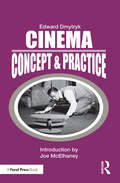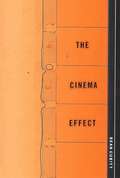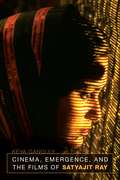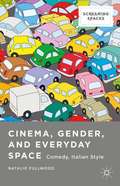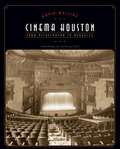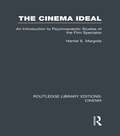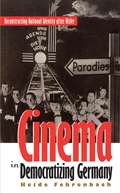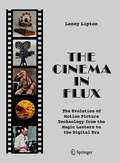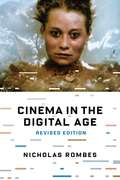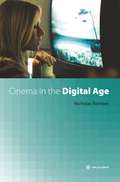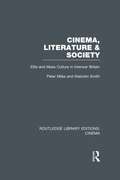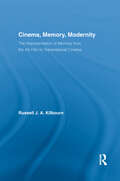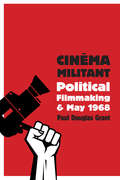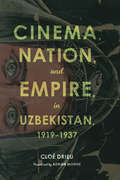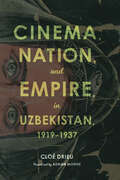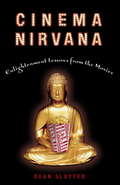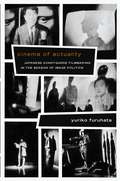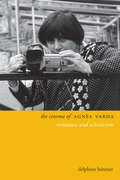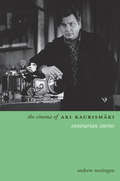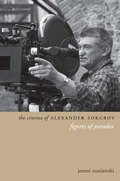- Table View
- List View
Cinema: Themes And Variations (Edward Dmytryk: On Filmmaking)
by Edward DmytrykIn this unique study of the process of filmmaking, director Edward Dmytryk blends abstract film theory and the practical realities of feature film production to provide an artful and elegant analysis of the conceptual foundations of filmmaking and film studies. Dmytryk explores the technical principles underlying the craft of filmmaking and how their use is effective in developing the viewer’s involvement in the cinematic narrative. Originally published in 1988, this reissue of Dmytryk’s classic book includes a new critical introduction by Joe McElhaney.
The Cinema Effect
by Sean CubittIn this highly original examination of time in film, Sean Cubitt tries to get at the root of the uncanny effect produced by images and sounds that don't quite align with reality.
Cinema, Emergence, and the Films of Satyajit Ray
by Keya GangulyThe book shows how Satyajit Ray, a renowned Indian filmmaker, redefines the grammar of cinema to make possible a vision of society unavailable in the novel or theater and documents the capacity of the image to conceptualize a different world.
Cinema, Gender, And Everyday Space
by Natalie FullwoodCommedia all'italiana, or Comedy, Italian style, became popular at a time of great social change. This book, utilizing comedies produced in Italy from 1958-70, examines the genre's representation of gender in the everyday spaces of beaches and nightclubs, offices, cars, and kitchens, through the exploration of key spatial motifs.
Cinema Houston
by David WellingCinema Houston celebrates a vibrant century of movie theatres and moviegoing in Texas's largest city. Illustrated with more than two hundred historical photographs, newspaper clippings, and advertisements, it traces the history of Houston movie theatres from their early twentieth-century beginnings in vaudeville and nickelodeon houses to the opulent downtown theatres built in the 1920s (the Majestic, Metropolitan, Kirby, and Loew's State). It also captures the excitement of the neighborhood theatres of the 1930s and 1940s, including the Alabama, Tower, and River Oaks; the theatres of the 1950s and early 1960s, including the Windsor and its Cinerama roadshows; and the multicinemas and megaplexes that have come to dominate the movie scene since the late 1960s. While preserving the glories of Houston's lost movie palaces-only a few of these historic theatres still survive-Cinema Houston also vividly re-creates the moviegoing experience, chronicling midnight movie madness, summer nights at the drive-in, and, of course, all those tasty snacks at the concession stand. Sure to appeal to a wide audience, from movie fans to devotees of Houston's architectural history, Cinema Houston captures the bygone era of the city's movie houses, from the lowbrow to the sublime, the hi-tech sound of 70mm Dolby and THX to the crackle of a drive-in speaker on a cool spring evening.
The Cinema Ideal: An Introduction to Psychoanalytic Studies of the Film Spectator (Routledge Library Editions: Cinema)
by Harriet E. MargolisThis study explores the model derived from Freudian and Lacanian psychoanalysis, via Marxism and semiotics, of looking at film. It retraces the steps of film theory from ideological criticism of the late ‘60s to spectator studies in 1988 when the book was originally published. Psychoanalysis enables a discussion of the cinema’s role as a social and political force and this book enters a discourse of the politics of representation. Reconstructing discussion of basic issues, the book addresses our instincts and defences in reacting to cinema, the similarity between mental processes and cinematic technique, narrative techniques and the ‘cinematic apparatus’. Importantly, the book concerns itself with the concept of ideology and how the filmviewing experience engages the spectator in a complex net of stimuli presenting representations of an ideal world and the effect of this within film studies.
Cinema in Democratizing Germany
by Heide FehrenbachHeide Fehrenbach analyzes the important role cinema played in the reconstruction of German cultural and political identity between 1945 and 1962. Concentrating on the former West Germany, she explores the complex political uses of film--and the meanings attributed to film representation and spectatorship--during a period of abrupt transition to democracy. According to Fehrenbach, the process of national redefinition made cinema and cinematic control a focus of heated ideological debate. Moving beyond a narrow political examination of Allied-German negotiations, she investigates the broader social nexus of popular moviegoing, public demonstrations, film clubs, and municipal festivals. She also draws on work in gender and film studies to probe the ways filmmakers, students, church leaders, local politicians, and the general public articulated national identity in relation to the challenges posed by military occupation, American commercial culture, and redefined gender roles. Thus highlighting the links between national identity and cultural practice, this book provides a richer picture of what German reconstruction entailed for both women and men.
The Cinema in Flux: The Evolution of Motion Picture Technology from the Magic Lantern to the Digital Era
by Lenny LiptonThe first of its kind, this book traces the evolution of motion picture technology in its entirety. Beginning with Huygens' magic lantern and ending in the current electronic era, it explains cinema’s scientific foundations and the development of parallel enabling technologies alongside the lives of the innovators. Product development issues, business and marketplace factors, the interaction of aesthetic and technological demands, and the patent system all play key roles in the tale. The topics are covered sequentially, with detailed discussion of the transition from the magic lantern to Edison’s invention of the 35mm camera, the development of the celluloid cinema, and the transition from celluloid to digital. Unique and essential reading from a lifetime innovator in the field of cinema technology, this engaging and well-illustrated book will appeal to anyone interested in the history and science of cinema, from movie buffs to academics and members of the motion picture industry.
Cinema in the Digital Age
by Nicholas RombesHave digital technologies transformed cinema into a new art, or do they simply replicate and mimic analogue, film-based cinema? Newly revised and expanded to take the latest developments into account, Cinema in the Digital Age examines the fate of cinema in the wake of the digital revolution. Nicholas Rombes considers Festen (1998), The Blair Witch Project (1999), Timecode (2000), Russian Ark (2002), and The Ring (2002), among others. Haunted by their analogue pasts, these films are interested not in digital purity but rather in imperfection and mistakes—blurry or pixilated images, shaky camera work, and other elements that remind viewers of the human behind the camera.With a new introduction and new material, this updated edition takes a fresh look at the historical and contemporary state of digital cinema. It pays special attention to the ways in which nostalgia for the look and feel of analogue disrupts the aesthetics of the digital image, as well as how recent films such as The Social Network (2010) and The Girl with the Dragon Tattoo (2011)—both shot digitally—have disguised and erased their digital foundations. The book also explores new possibilities for writing about and theorizing film, such as randomization.
Cinema in the Digital Age
by Nicholas RombesDoes the digital era spell the death of cinema as we know it? Or is it merely heralding its rebirth? Are we witnessing the emergence of something entirely new? Cinema in the Digital Age examines the fate of cinema in this new era, paying special attention to the technologies that are reshaping film and their cultural impact. Examining Festen (1998), The Blair Witch Project (1999), Timecode (2000), Russian Ark (2002), The Ring (2002), among others, this volume explores how these films are haunted by their analogue past and suggests that their signature element are their deliberate imperfections, whether those take the form of blurry or pixilated images, shakey camera work, or other elements reminding viewers of the human hand guiding the camera. Weaving together a rich variety of sources, Cinema in the Digital Age provides a deeply humanistic look at the meaning of cinematic images in the era of digital perfection.
Cinema in the Digital Age
by Nicholas RombesDoes the digital era spell the death of cinema as we know it? Or is it merely heralding its rebirth? Are we witnessing the emergence of something entirely new? Cinema in the Digital Age examines the fate of cinema in this new era, paying special attention to the technologies that are reshaping film and their cultural impact. Examining Festen (1998), The Blair Witch Project (1999), Timecode (2000), Russian Ark (2002), The Ring (2002), among others, this volume explores how these films are haunted by their analogue past and suggests that their signature element are their deliberate imperfections, whether those take the form of blurry or pixilated images, shakey camera work, or other elements reminding viewers of the human hand guiding the camera. Weaving together a rich variety of sources, Cinema in the Digital Age provides a deeply humanistic look at the meaning of cinematic images in the era of digital perfection.
Cinema, Literature & Society: Elite and Mass Culture in Interwar Britain (Routledge Library Editions: Cinema)
by Malcolm Smith Peter MilesDuring the interwar period cinema and literature seemed to be at odds with each other, part of the continuing struggle between mass and elite culture which so worried writers such as Aldous Huxley, T.S. Eliot and the Leavises. And this cultural divide appeared to be sharp evidence of a deeper struggle for control of the nation’s consciousness, not only between dominant and oppositional elements within Britain, but between British and American vales as well. On the one hand, films like Sing As We Go, Proud Valley, and The Stars Look Down consolidated the assumptions about the existence of a national rather than separate class identities. On the other hand, working-class literature such as Love on the Dole articulated working-class experience in a manner intended to bridge the gap between the ‘Two Englands’. This book, originally published in 1987, examines how two of the most significant cultural forms in Britain contributed indirectly to the stability of Britain in the interwar crisis, helping to construct a new class alliance. A major element in the investigation is an analysis of the mechanics of the development of a national cultural identity, alongside separate working-class culture, the development of the lower-middle class and the implications of the intrusion of Hollywood culture. The treatment throughout is thematic rather than text-oriented – works of Graham Greene, George Orwell, Bert Coombes, Evelyn Waugh, the British Documentary Film Movement and Michael Balcon are included in the wide range of material covered.
Cinema, Memory, Modernity: The Representation of Memory from the Art Film to Transnational Cinema (Routledge Advances in Film Studies #6)
by Russell J.A. KilbournSince its inception, cinema has evolved into not merely a ‘reflection’ but an indispensable index of human experience – especially our experience of time’s passage, of the present moment, and, most importantly perhaps, of the past, in both collective and individual terms. In this volume, Kilbourn provides a comparative theorization of the representation of memory in both mainstream Hollywood and international art cinema within an increasingly transnational context of production and reception. Focusing on European, North and South American, and Asian films, Kilbourn reads cinema as providing the viewer with not only the content and form of memory, but also with its own directions for use: the required codes and conventions for understanding and implementing this crucial prosthetic technology — an art of memory for the twentieth-century and beyond.
Cinéma Militant: Political Filmmaking and May 1968
by Paul Douglas GrantThis history covers the filmmaking tradition often referred to as cinéma militant, which emerged in France during the events of May 1968 and flourished for a decade. While some films produced were created by established filmmakers, including Chris Marker, Jean-Luc Godard, and William Klein, others were helmed by left-wing filmmakers working in the extreme margins of French cinema. This latter group gave voice to underrepresented populations, such as undocumented immigrants (sans papiers), entry-level factory workers (ouvriers spécialisés), highly intellectual Marxist-Leninist collectives, and militant special interest groups. While this book spans the broad history of this uncharted tradition, it particularly focuses on these lesser-known figures and works and the films of Cinélutte, Les groupes medvedkine, Atelier de recherche cinématographique, Cinéthique, and the influential Marxist filmmaker Jean-Pierre Thorn. Each represent a certain tendency of this movement in French film history, offering an invaluable account of a tradition that also sought to share untold histories.
Cinéma Militant: Political Filmmaking and May 1968
by Paul Douglas GrantThis history covers the filmmaking tradition often referred to as cinéma militant, which emerged in France during the events of May 1968 and flourished for a decade. While some films produced were created by established filmmakers, including Chris Marker, Jean-Luc Godard, and William Klein, others were helmed by left-wing filmmakers working in the extreme margins of French cinema. This latter group gave voice to underrepresented populations, such as undocumented immigrants (sans papiers), entry-level factory workers (ouvriers spécialisés), highly intellectual Marxist-Leninist collectives, and militant special interest groups. While this book spans the broad history of this uncharted tradition, it particularly focuses on these lesser-known figures and works and the films of Cinélutte, Les groupes medvedkine, Atelier de recherche cinématographique, Cinéthique, and the influential Marxist filmmaker Jean-Pierre Thorn. Each represent a certain tendency of this movement in French film history, offering an invaluable account of a tradition that also sought to share untold histories.
Cinema, Nation, and Empire in Uzbekistan, 1919-1937
by Cloé DrieuBetween the founding of Soviet Uzbekistan in 1924 and the Stalinist Terror of the late 1930s, a nationalist cinema emerged in Uzbekistan giving rise to the first wave of national film production and an Uzbek cinematographic elite. In Cinema, Nation, and Empire in Uzbekistan Cloé Drieu uses Uzbek films as a lens to explore the creation of the Soviet State in Central Asia, starting from the collapse of the Russian Empire up through the eve of WWII. Drieu argues that cinema provides a perfect angle for viewing the complex history of domination, nationalism, and empire (here used to denote the centralization of power) within the Soviet sphere. By exploring all of film’s dimensions as a socio-political phenomenon—including film production, film reception, and filmic discourse—Drieu reveals how nation and empire were built up as institutional realities and as imaginary constructs. Based on archival research in the Uzbek and Russian State Archives and on in-depth analyses of 14 feature-length films, Drieu’s work examines the lively debates within the totalitarian and so-called revisionist schools that invigorated Soviet historiography, positioning itself within contemporary discussions about the processes of state- and nation-building, and the emergence of nationalism more generally. Revised and expanded from the original French, Cinema, Nation, and Empire in Uzbekistan helps us to understand how Central Asia, formerly part of the Russian Empire, was decolonized, but later, in the run-up to the Stalinist period and repression of the late 1930s, suffered a new style of domination.
Cinema, Nation, and Empire in Uzbekistan, 1919–1937
by Cloé DrieuThis study examines the creation of the Soviet State in Central Asia through the lens of Uzbek cinema—from the collapse of the Russian Empire to WWII.Between the founding of Soviet Uzbekistan in 1924 and the Stalinist Terror of the late 1930s, a nationalist cinema emerged. In Cinema, Nation, and Empire in Uzbekistan Cloé Drieu argues that the Uzbek films of this period provide a perfect angle for viewing the complex history of domination, nationalism, and empire building within the Soviet sphere. By exploring all of film’s dimensions—including production, reception, and discourse—Drieu reveals how nation and empire were built up as institutional realities and as imaginary constructs.Combining research in the Uzbek and Russian State Archives and in-depth analyses of fourteen films, Drieu’s work examines the debates within the totalitarian and so-called revisionist schools that invigorated Soviet historiography. Revised and expanded from the original French, Cinema, Nation, and Empire in Uzbekistan helps us to understand how Central Asia, formerly part of the Russian Empire, was decolonized, only to suffer a new style of domination in the run-up to the Stalinist period and repression of the late 1930s.
Cinema Nirvana
by Dean SluyterMovie fans and spiritual seekers, unite! In Cinema Nirvana, meditation teacher and award-winning film critic Dean Sluyter illuminates the hidden enlightenment teachings of Casablanca, Jaws, The Graduate, The Godfather, Memento, and ten other classic films, revealing spiritual wisdom in everything from 007's secret weapons to the colors of the Seven Dwarfs' eyes. So grab your popcorn, sit back, and prepare to have your mind opened.
Cinema of Actuality: Japanese Avant-Garde Filmmaking in the Season of Image Politics
by Yuriko FuruhataDuring the 1960s and early 1970s, Japanese avant-garde filmmakers intensely explored the shifting role of the image in political activism and media events. Known as the "season of politics," the era was filled with widely covered dramatic events from hijackings and hostage crises to student protests. This season of politics was, Yuriko Furuhata argues, the season of image politics. Well-known directors, including Oshima Nagisa, Matsumoto Toshio, Wakamatsu Kōji, and Adachi Masao, appropriated the sensationalized media coverage of current events, turning news stories into material for timely critique and intermedial experimentation. Cinema of Actuality analyzes Japanese avant-garde filmmakers' struggle to radicalize cinema in light of the intensifying politics of spectacle and a rapidly changing media environment, one that was increasingly dominated by television. Furuhata demonstrates how avant-garde filmmaking intersected with media history, and how sophisticated debates about film theory emerged out of dialogues with photography, television, and other visual arts.
The Cinema of Agnès Varda: Resistance and Eclecticism (Directors' Cuts)
by Delphine BenezetAgnès Varda, a pioneer of the French New Wave, has been making radical films for over half a century. Many of these are considered by scholars, filmmakers, and audiences alike, as audacious, seminal, and unforgettable. This volume considers her production as a whole, revisiting overlooked films like Mur, Murs/Documenteur (1980–81), and connecting her cinema to recent installation work. This study demonstrates how Varda has resisted norms of representation and diktats of production. It also shows how she has elaborated a personal repertoire of images, characters, and settings, which all provide insight on their cultural and political contexts. The book thus offers new readings of this director's multifaceted rêveries, arguing that her work should be seen as an aesthetically influential and ethically-driven production where cinema is both a political and collaborative practice, and a synesthetic art form.
The Cinema of Agnès Varda
by Delphine BenezetAgnès Varda, a pioneer of the French New Wave, has been making radical films for over half a century. Many of these are considered by scholars, filmmakers, and audiences alike, as audacious, seminal, and unforgettable. This volme considers her production as a whole, revisiting overlooked films like Mur, Murs/Documenteur (1980--81), and connecting her cinema to recent installation work. This study demonstrates how Varda has resisted norms of representation and diktats of production. It also shows how she has elaborated a personal repertoire of images, characters, and settings, which all provide insight on their cultural and political contexts. The book thus offers new readings of this director's multifaceted rêveries, arguing that her work should be seen as an aesthetically influential and ethically-driven production where cinema is both a political and collaborative practice, and a synesthetic art form.
The Cinema of Aki Kaurismäki: Contrarian Stories (Directors' Cuts)
by Andrew NestingenAki Kaurismäki is an enigma, an eminent auteur who claims his films are a joke. Since 1983, Kaurismäki has produced classically-styled films filled with cinephilic references to film history. He has earned an international art-house audience and many prizes, influencing such directors as Jim Jarmusch, Quentin Tarantino, and Wes Anderson. Yet Kaurismäki is often depicted as the loneliest, most nostalgic of Finns (except when he promotes his films, makes political statements, and runs his many businesses). He is also depicted as a bohemian known for outlandish actions and statements. The Cinema of Aki Kaurismäki is the first comprehensive English-language study of this eccentric director. Drawing on revisionist approaches to film authorship, the text links the filmmaker and his films to the stories and issues animating film aesthetics and history, nostalgia, late modernity, politics, commerce, film festivals, and national cinema.
The Cinema of Aki Kaurismäki: Contrarian Stories
by Andrew NestingenAki Kaurismäki is an enigma, an eminent auteur who claims his films are a joke. Since 1983, Kaurismäki has produced classically-styled films filled with cinephilic references to film history. He has earned an international art-house audience and many prizes, influencing such directors as Jim Jarmusch, Quentin Tarantino, and Wes Anderson. Yet Kaurismäki is often depicted as the loneliest, most nostalgic of Finns (except when he promotes his films, makes political statements, and runs his many businesses). He is also depicted as a bohemian known for outlandish actions and statements. The Cinema of Aki Kaurismäki is the first comprehensive English-language study of this eccentric director. Drawing on revisionist approaches to film authorship, the text links the filmmaker and his films to the stories and issues animating film aesthetics and history, nostalgia, late modernity, politics, commerce, film festivals, and national cinema.
The Cinema of Alexander Sokurov: Figures of Paradox (Directors' Cuts)
by Jeremi SzaniawskiOne of the last representatives of a brand of serious, high-art cinema, Alexander Sokurov has produced a massive oeuvre exploring issues such as history, power, memory, kinship, death, the human soul, and the responsibility of the artist. Through contextualization and close readings of each of his feature fiction films (broaching many of his documentaries in the process), this volume unearths a vision of Sokurov's films as equally mournful and passionate, intellectual, and sensual, and also identifies in them a powerful, if discursively repressed, queer sensitivity, alongside a pattern of tensions and paradoxes. This book thus offers new keys to understand the lasting and ever-renewed appeal of the Russian director's Janus-like and surprisingly dynamic cinema – a deeply original and complex body of work in dialogue with the past, the present and the future.
The Cinema of Alexander Sokurov: Figures of Paradox
by Jeremi SzaniawskiOne of the last representatives of a brand of serious, high-art cinema, Alexander Sokurov has produced a massive oeuvre exploring issues such as history, power, memory, kinship, death, the human soul, and the responsibility of the artist. Through contextualization and close readings of each of his feature fiction films (broaching many of his documentaries in the process), this volume unearths a vision of Sokurov's films as equally mournful and passionate, intellectual, and sensual, and also identifies in them a powerful, if discursively repressed, queer sensitivity, alongside a pattern of tensions and paradoxes. This book thus offers new keys to understand the lasting and ever-renewed appeal of the Russian director's Janus-like and surprisingly dynamic cinema -- a deeply original and complex body of work in dialogue with the past, the present and the future.
